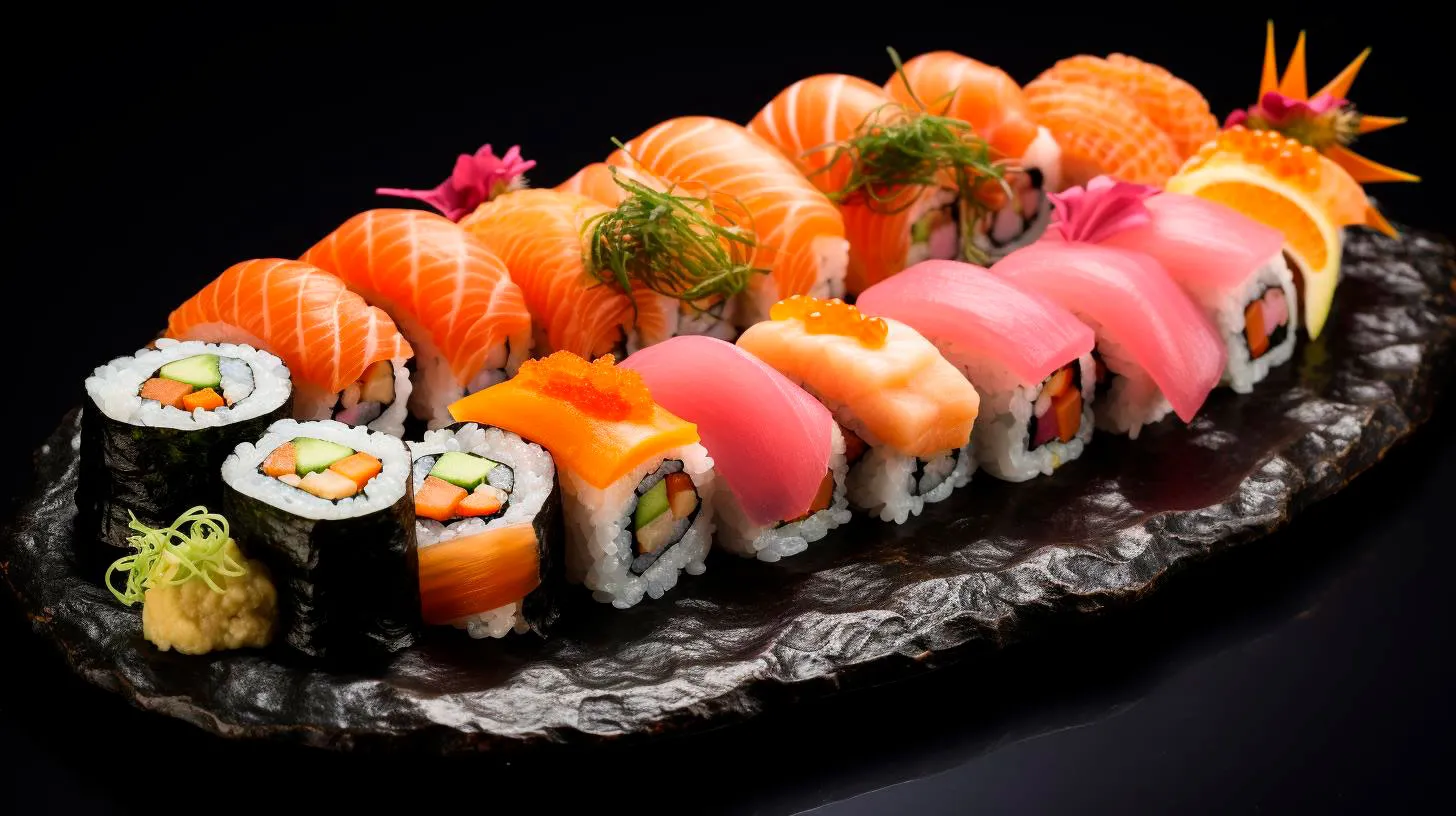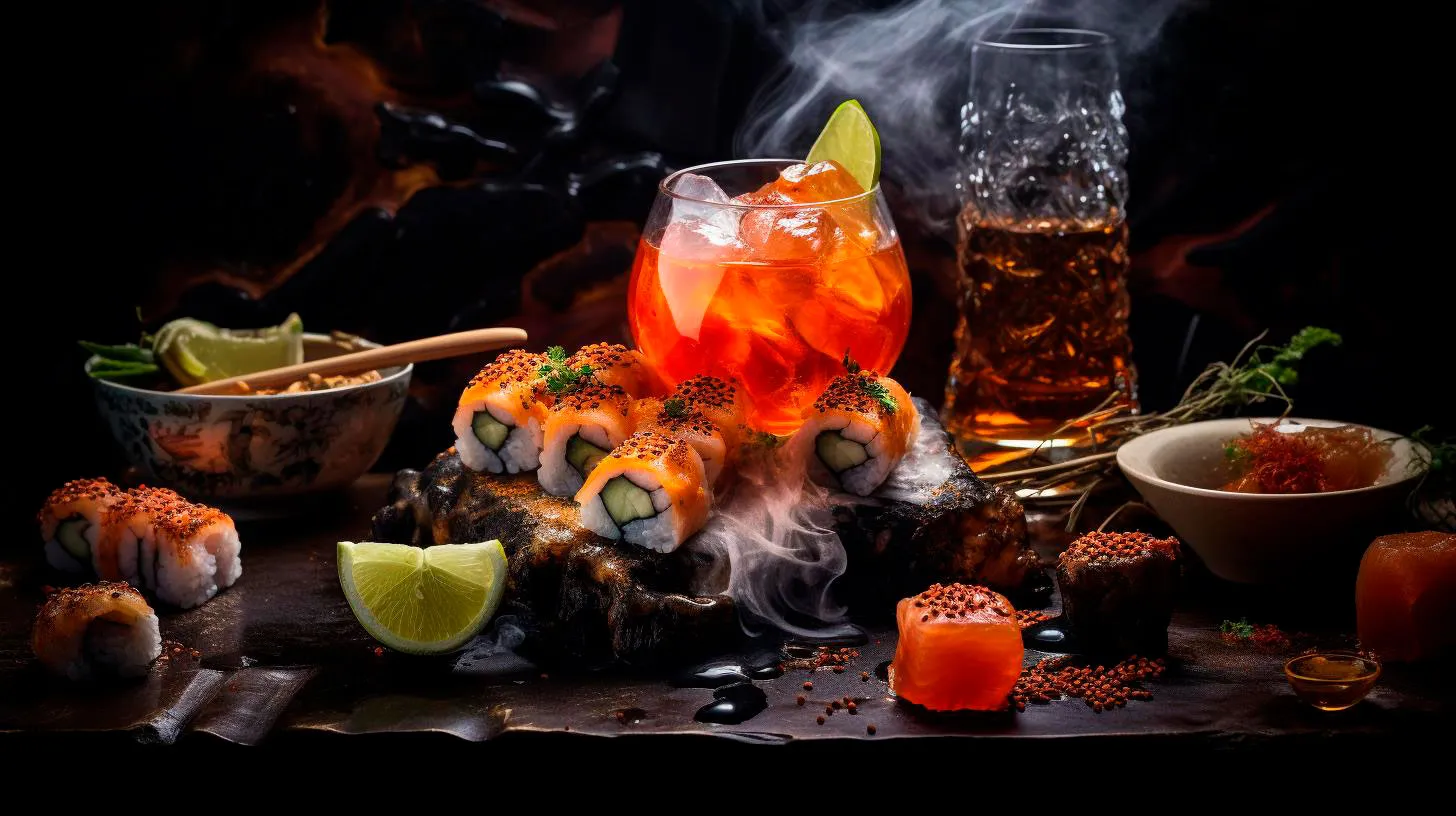All-You-Can-Eat Sushi vs À la Carte: Decoding Your Sushi Dining Experience
In this article, we’ll explore the key differences between all-you-can-eat sushi and à la carte dining experiences. By the end, you’ll have a clearer picture of which option suits your preferences and cravings!
All-You-Can-Eat Sushi: A Feast for Sushi Lovers
If you’re a sushi aficionado with a healthy appetite, the allure of all-you-can-eat sushi is hard to resist. This dining experience offers an endless parade of sushi creations without limiting your choices. Here’s what you should know:
- Wide Selection: All-you-can-eat sushi restaurants boast an extensive menu featuring a variety of rolls, nigiri, sashimi, and appetizers. From classic favorites to unique creations, there’s something for everyone.
- Value for Money: With a fixed price, all-you-can-eat sushi allows you to indulge in as much sushi as you desire. This can be an economical choice, especially if you have a big appetite or are dining with friends who share your love for sushi.
- Time Limitations: It’s essential to keep in mind that most all-you-can-eat sushi restaurants impose a time limit for dining. While this ensures a smooth flow of customers, it may restrict the leisurely pace you’d prefer during your meal.
While all-you-can-eat sushi offers an impressive array of choices, it’s important to remember that the quality of sushi can vary between establishments. Additionally, the speed of service may influence the overall dining experience.
À la Carte Sushi: Embrace Tradition and Selectivity
For those seeking a more refined and customized sushi experience, à la carte dining is the way to go. Here are some key points to consider:
- Quality over Quantity: In an à la carte sushi restaurant, the focus is on delivering the highest quality sushi rather than overwhelming variety. Each piece of sushi is crafted with precision and care, allowing you to savor the flavors and textures.
- Chef’s Expertise: À la carte dining places the spotlight on the sushi chef’s skills and creativity. You have the opportunity to interact with the chef, seek their recommendations, and even request custom-made sushi to suit your taste.
- Savor the Experience: À la carte dining encourages a slow-paced meal, where you can relish each bite and fully immerse yourself in the sushi experience. It’s an excellent option for special occasions or when you want to enjoy sushi as an art form.
While à la carte sushi offers unparalleled quality, it may not be as cost-effective as the all-you-can-eat option. Additionally, depending on the restaurant’s popularity, there might be a wait time for a table, especially during peak hours.
The Verdict: Choosing the Best Sushi Experience
Ultimately, the choice between all-you-can-eat sushi and à la carte dining depends on your personal preferences and dining goals.
If you want to sample a wide variety of sushi creations and fill your plate again and again without worrying about the bill, then all-you-can-eat sushi is the way to go. It’s perfect for casual outings with friends or when you have a big appetite.
On the other hand, if you seek an intimate and refined sushi experience, where the quality of each piece shines through and you appreciate the culinary artistry involved, then à la carte dining will fulfill your desires. It’s ideal for special occasions or when you simply want to treat yourself to sushi perfection.
Remember, whether you opt for all-you-can-eat or à la carte, it’s essential to choose a reputable sushi restaurant that prioritizes freshness, cleanliness, and flavor. Reading reviews, seeking recommendations, and exploring local sushi scene statistics will help you find the best dining establishment in your area.
Sushi is a culinary journey, and both all-you-can-eat sushi and à la carte dining offer unique experiences. So, go ahead and savor the flavors, textures, and artistry of sushi – whichever dining style you choose!
Unveiling the Art of Preparing Sushi in Traditional vs Modern Techniques
Traditional Sushi Techniques
In the traditional method, sushi masters adhere to centuries-old practices that have been passed down through generations. These techniques require exceptional skill, precision, and years of training to perfect. Here are some key aspects of traditional sushi preparation:
- Knife Skills: Sushi masters believe that knife skills are foundational to creating the perfect sushi. They spend years honing their techniques to ensure clean, precise cuts, allowing the flavors to shine.
- Hand-Formed Nigiri: Traditional sushi involves hand-forming each nigiri. The chef gently molds the rice, ensuring the perfect balance and shape, then tops it with a slice of fresh fish or other delicate ingredients.
- Use of Traditional Ingredients: Traditional sushi relies on the use of authentic ingredients like nori (seaweed), wasabi, and pickled ginger. These elements add depth and complexity to the dish.
- Minimalism: Traditional sushi values simplicity and elegance. It aims to showcase the natural flavors of the fish, rather than overwhelming them with excessive amounts of sauce or seasoning.
Modern Sushi Techniques
The evolution of sushi has given rise to modern techniques that cater to different tastes and preferences. While still honoring the fundamentals of sushi-making, modern approaches bring an innovative twist to the traditional art form. Here are some characteristics of modern sushi techniques:
- Creative Ingredient Combinations: Modern sushi chefs experiment with unconventional ingredients, introducing unique flavor profiles to complement traditional elements. They incorporate ingredients like avocado, cream cheese, and various vegetables to create exciting new sushi rolls.
- Specialized Tools: Advancements in sushi-making have led to the development of specialized tools that aid in precise preparation. Sushi mats, rice cookers, and cutting guides are some examples of modern tools that enhance efficiency and consistency.
- Artistic Presentation: Modern sushi techniques prioritize visual appeal, with chefs creating stunning sushi platters that are a feast for the eyes. Intricate garnishes, edible flowers, and colorful arrangements add an artistic touch to the dish.
- Sauce Innovation: Modern sushi embraces a variety of sauces and dressings to enhance flavors and create unique taste experiences. Chefs incorporate spicy mayo, eel sauce, and citrus-based dressings to elevate the overall sushi experience.
Key Takeaways
Sushi-making is an art form that has evolved over time, with traditional and modern techniques both offering distinct advantages. Here are some key takeaways:
- The traditional approach emphasizes knife skills, hand-formed nigiri, and the use of authentic ingredients, allowing the natural flavors of the fish to shine.
- The modern techniques introduce creativity and innovation, incorporating unique ingredients, artistic presentation, and a variety of sauces to enhance the overall sushi experience.
- Both traditional and modern sushi techniques require skill, precision, and a deep understanding of flavor combinations to deliver a memorable culinary experience.
- Whether you prefer the simplicity of traditional sushi or the adventurous flavors of modern sushi, the ultimate goal remains the same – to savor the exquisite art of sushi-making.
So, the next time you indulge in a plate of sushi, take a moment to appreciate the craftsmanship behind it, whether it follows traditional techniques or embraces a modern twist.
Sources:
– Japanese Cuisine: A Culinary Tour
– Sushi: The Essential Guide to the World’s Most Iconic Food
– The Modern Art of Sushi
Exploring the Freshness Factor
So, let’s dive in and explore the significance of the freshness factor in search engine optimization (SEO).
Understanding the Freshness Factor
In simple terms, the freshness factor refers to the relevance and recency of a particular webpage or article. Search engines, like Google, prioritize websites that provide users with the most recent and accurate information. This means that websites with updated content are more likely to earn higher rankings in search engine result pages (SERPs).
Now, you might be wondering why freshness matters for your website. Well, the answer is quite simple – internet users crave the latest and most relevant information. By consistently updating your content, you can satisfy their hunger for fresh news, up-to-date trends, and informative articles.
Advantages of Embracing the Freshness Factor
- Improved Search Engine Rankings: When search engines identify and index updated content on your website, it increases your chances of ranking higher in search results.
- Increased Organic Traffic: Fresh and updated content attracts more visitors to your website, resulting in increased organic traffic.
- Enhanced User Experience: By providing users with the latest information, you can offer them a better experience on your website, increasing their engagement and loyalty.
- Stay Ahead of Competitors: Regularly updating your content keeps you ahead in the competitive online landscape. Freshness acts as a unique selling point that sets you apart from your competitors.
Key Takeaways to Boost Freshness
Now that we have discussed the importance of the freshness factor, let’s look at some key takeaways to help you ensure your website stays fresh and up to date:
- Regularly Publish Fresh Content: Keep your website dynamic and attract search engine bots by updating your content frequently. Consistently publishing well-researched articles or blog posts can significantly improve your website’s freshness factor.
- Revamp Stale Content: Identify outdated pages or articles on your website and refresh them to ensure they remain relevant and informative. Adding updated statistics, current examples, or new insights can bring life back to older content.
- Monitor Industry Trends: Stay updated with the latest industry trends and news. Incorporate this knowledge into your content strategy to provide timely and valuable information to your audience.
- Engage with User Feedback: Encourage user interaction through comments, social media, forums, or surveys. Actively responding to user feedback and incorporating their suggestions shows that you value their opinions and helps keep your content relevant.
- Promote Fresh Content: Once you publish new content, promote it through various channels such as social media, newsletters, or email marketing. This helps drive traffic to your fresh content and increases its visibility.
Remember, while embracing the freshness factor is crucial for your website’s success, it is also important to maintain a balance between creating fresh content and relevancy. Focus on delivering valuable and timely information to your audience, and search engines will reward you with higher rankings and increased organic traffic.
So, take a moment to analyze your website’s content and start implementing the freshness factor in your SEO strategy. By staying consistently fresh, relevant, and engaging, you’ll be one step closer to achieving online success.
Decoding the Fish Selection at Sushi Restaurants
Understanding Popular Fish Choices
1. Tuna
- Known for its high-quality flavor and rich texture, tuna is a staple in sushi.
- The two main types of tuna used in sushi are maguro (bluefin tuna) and albacore (white tuna).
- Maguro has a distinct reddish color and is often served as nigiri or sashimi.
- Albacore, also known as shiro maguro, has a milder flavor and is commonly used in rolls.
2. Salmon
- Salmon is prized for its vibrant orange color and delicate flavor.
- It is commonly served as nigiri, sashimi, or in rolls.
- Wild-caught salmon is considered a healthier choice due to its Omega-3 fatty acids.
3. Yellowtail
- Yellowtail, also known as hamachi, offers a buttery texture and a mild, slightly sweet flavor.
- It is often used in nigiri, sashimi, and rolls.
- Yellowtail is a popular choice among sushi enthusiasts and pairs well with other flavors.
4. Shrimp
- Shrimp is a versatile option that provides a subtly sweet taste and firm texture.
- Commonly found in tempura rolls or nigiri, shrimp is a perfect choice for those new to sushi.
- Ebi (boiled shrimp) and amaebi (sweet shrimp) are two popular variations.
Exploring Exotic Fish Choices
1. Uni (Sea Urchin)
- Uni has a distinct creamy and briny flavor that is loved by sushi connoisseurs.
- It is considered a delicacy and is often used in nigiri or served atop sushi rolls.
- Uni is high in nutrients and provides a unique taste experience.
2. Eel
- Unagi, freshwater eel, is commonly found in sushi restaurants.
- It is typically grilled and brushed with a sweet soy-based glaze.
- Eel offers a rich, smoky flavor and a tender texture.
3. Octopus
- Octopus, or tako, has a chewy texture and a subtle oceanic flavor.
- It is often sliced thinly and served with a drizzle of soy sauce.
- Tako is enjoyed both in nigiri and sashimi forms.
4. Toro
- Toro is the fatty part of the tuna, prized for its melt-in-your-mouth texture.
- It is considered a premium choice and is often served as nigiri.
- Toro comes in different grades, with the highest, otoro, being the most prized and expensive.
Key Takeaways for Sushi Selection
1. Quality is everything: Opt for sushi restaurants that source high-quality, fresh fish from reputable suppliers.
2. Experiment with flavors: Don’t be afraid to try new fish varieties to expand your palate.
3. Consider sustainability: Choose fish from sustainable sources to support the environment and promote responsible fishing practices.
4. Trust the chef: Let the sushi chef guide you in selecting the best fish options based on availability and seasonal specialties.
5. Take note of your preferences: Over time, develop your own favorites and preferences to make future dining experiences even more enjoyable.
By understanding the fish selection at sushi restaurants, you can make informed choices and truly appreciate the artistry and flavors behind each sushi creation. Whether you prefer the classic tuna or want to venture into the realm of exotic options like uni or toro, the seafood extravaganza awaits.


